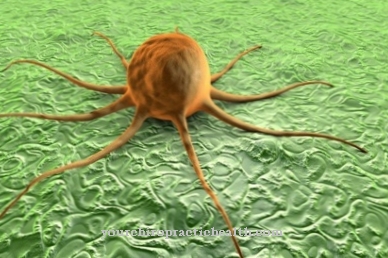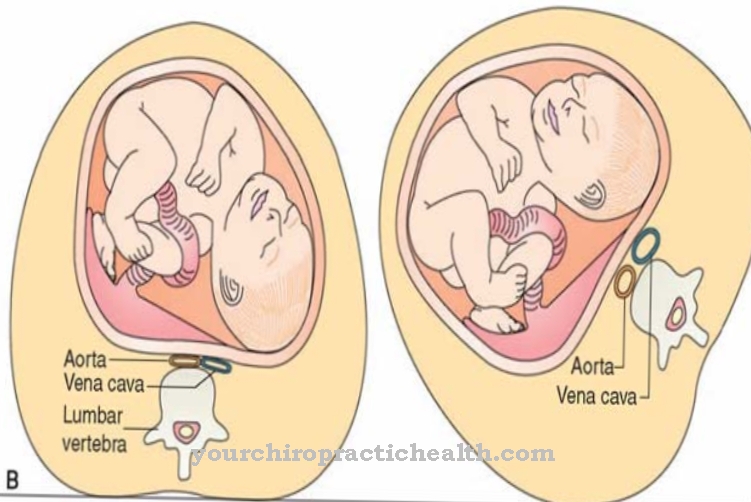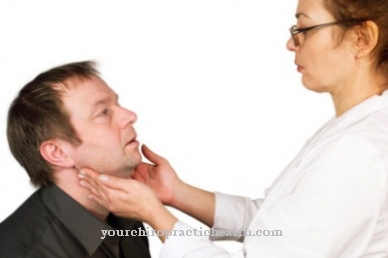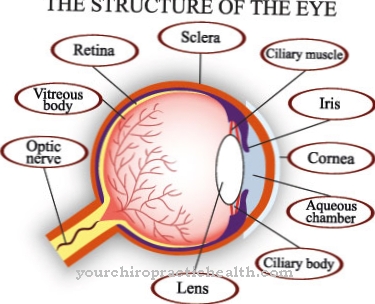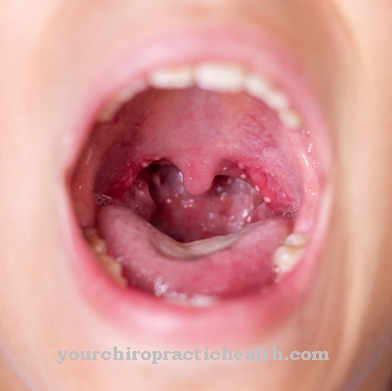Some people have an excruciating urge to urinate, which forces them to go to the toilet quickly. Sometimes this can lead to one Urge incontinence come, an involuntary leakage of urine.
What is urge incontinence?
As Urge incontinence or Urge incontinence In medicine, an abrupt, almost uncontrollable urge to urinate is referred to, which can be accompanied by involuntary urination. This type of incontinence is caused by a sensitive, overactive bladder. There are essentially two forms of urge incontinence:
- In sensory urge incontinence, the bladder reacts with an urge to urinate even when it is low.
- In motor urge incontinence, there is a disorder of the nerves responsible for emptying the bladder, which causes the bladder sphincter to contract like a spasm.
In both cases it is not a question of a disorder of the sphincter muscle, but rather a malfunction of the bladder muscle, in which even a low bladder filling level triggers extreme bladder pressure.
causes
The most common causes include lower urinary tract inflammation, especially sensory urge incontinence. It can be caused by frequent bladder infections or bladder stones. The sensors that transmit the level of the bladder to the brain are sensitive. The brain reacts with reflexive contraction of the bladder muscles. If the bladder is not properly filled, small amounts of urine will pass frequently as a result.
In motor urge incontinence, the signals between the bladder and the brain do not work properly.Urine leakage cannot be controlled when the muscle responsible for emptying the bladder contracts and the pressure in the bladder increases. Those affected feel a strong urge to go to the toilet quickly.
Neurological diseases such as stroke, multiple sclerosis, diabetes, Parkinson's and Alzheimer's can also lead to urinary incontinence. Sometimes a cup of coffee or other drink is enough to make you want to urinate. During the menopause it can also be due to a weak pelvic floor.
Symptoms, ailments & signs
The main symptom of urge incontinence is a sudden, tormenting urge to urinate, which usually cannot be suppressed. The urge can be so intense that those affected sometimes no longer manage to reach a toilet in time. There may be involuntary leakage of urine, but it can also lead to shorter bladder emptying intervals.
Anyone who suffers from urinary incontinence is constantly looking for the nearest toilet. Those affected usually have to urinate more than eight times a day, mostly at night. With excitement or psychological stress, the pressure increases. Cold can also encourage the urge to urinate or a sound of water. A lack of estrogen, such as occurs during menopause, makes the symptoms worse.
Diagnosis & course of disease
The doctor first takes a detailed anamnesis of the symptoms, whether there is an involuntary loss of urine. This is followed by a physical examination, usually a gynecological examination in women, to determine whether the uterus or vagina has subsided, whether there is a lack of estrogen and what the pelvic floor is like. The urine is examined to rule out a cystitis.
A cystoscopy is usually also done to check for bladder tumors, bladder stones, or an enlarged prostate. The filling capacity and degree of filling of the bladder can be assessed via an ultrasound examination. With a special transducer, the bladder and urethra can be examined from the vagina, including whether coughing or straining leads to a change in the situation.
Changes between rest and exercise phases can also be recorded. A measurement of the bladder pressure is useful to find out the causes of involuntary loss of urine. Due to the good technical possibilities of ultrasound examinations, X-ray examinations are rarely carried out. A voiding protocol can be a valuable addition.
Complications
Urgeinontinenz usually has a very negative effect on everyday life and on the life of the person affected. The patients suffer from frequent urination and in many situations can no longer hold the water in the bladder. In children, urinary incontinence can also lead to bullying or teasing, so that the patients also suffer from psychological complaints or depression.
These symptoms can also occur in adults. Those affected feel uncomfortable with it and in many cases are ashamed of the symptoms of urinary incontinence. This can also lead to reduced self-esteem or severe inferiority complexes. If the urinary incontinence is not treated, the disease can lead to urinary poisoning.
In the worst case, the affected person can die from this. The kidneys are also damaged in the course of the disease, so that renal insufficiency can also occur. Those affected are then dependent on a donor kidney or on dialysis. The disease significantly increases the risk of prostate cancer.
Treatment is always based on the cause, but without complications. The symptoms cannot be completely alleviated in every case. The disease may also limit the patient's life expectancy.
When should you go to the doctor?
In the case of urinary incontinence, the person affected should always consult a doctor immediately, as it is a serious illness that can significantly reduce the quality of life of the person concerned. It cannot heal on its own, so the patient should contact a doctor at the first symptoms and signs of urinary incontinence. As a rule, the earlier the disease is diagnosed, the better the further course.
A doctor should be consulted if the patient suffers from incontinence due to severe physical or emotional stress. Small amounts of urine appear, which can be small droplets. Those affected do not always recognize this drop. In many cases, severe pain in the bladder or ureter can also indicate urinary incontinence and should also be examined by a doctor. The symptoms do not have to be permanent. A urologist should be consulted with this disease. However, since the illness can also lead to mental upset or depression, a visit to a psychologist is usually necessary.
Treatment & Therapy
Since in most cases urinary incontinence is not caused by organic problems, the treatment is primarily aimed at improving the symptoms. First of all, targeted bladder training should enable better control of the bladder and increase the intervals between bladder emptying.
It is best to keep a micturition diary, which provides information about when the urge to urinate occurs, how quickly those affected give in to it, whether there is involuntary loss of urine, how much is drunk. In the case of urge incontinence, targeted pelvic floor training is also useful in most cases to strengthen the muscles. In addition to bladder training, drugs are usually prescribed that relax the bladder muscles and enable them to store a larger amount of urine again.
In most cases, anticholinergics are given. However, they can cause dry mouth, gastrointestinal problems, and dry skin. In milder cases, herbal remedies made with pumpkin can also help relieve irritation. Antibiotics are only prescribed for infections. Surgical procedures are rather not indicated for urge incontinence because the bladder's occlusion system is intact. Bladder stones are an exception because they have to be removed.
You can find your medication here
➔ Medicines for bladder and urinary tract healthprevention
One of the most important preventive measures is regular pelvic floor exercise. Anyone who suffers from obesity should reduce it, as the excess kilos put a strain on the pelvic floor. Regular exercise is good. Eating a balanced, healthy diet can help prevent constipation, which in turn puts a strain on the pelvic floor. Sufficient drinking ensures that the capacity of the bladder is trained. In addition to bladder training, it makes sense to learn relaxation techniques.
Aftercare
Follow-up care for urinary incontinence is necessary if the symptoms are permanent and the cause cannot be treated. Those affected need to receive adequate support in their everyday life. The effects of the complaints should burden life as little as possible. To this end, the doctor and patient agree on a rhythm of presentations in order to discuss the effectiveness of the measures.
In practice, medication, bladder training, and psychotherapy promise promising treatment success. The last aspect in particular is an important component. Because with a strong expression, uncontrolled urination can restrict everyday life. Many patients hardly dare to leave their home anymore. The medical history plays an important role in the scheduled follow-up examinations. In addition, neurological approaches can also be pursued.
Basically, doctors try to remedy the causes of urinary incontinence. Unfortunately, according to a statistical survey, this only succeeds in 20 percent of all cases. Since there are no longer any complaints by eliminating the trigger, there is no need for close follow-up checks, as is known from tumor diseases. After a complete healing, a recurrence is not to be expected. So far, no effective preventive measures are known to prevent urge incontinence from occurring again.
You can do that yourself
Urge incontinence is treated physically and medically. Any organic disturbances must be identified and remedied. Targeted bladder and toilet training can be used as a means of self-help. The results are noted in a urination diary so that the patient and doctor can treat the condition in a targeted manner.
In addition, a doctor-guided pelvic floor training is recommended, which is supported at home by physiotherapy, yoga and other strengthening measures. In parallel, drug treatment is necessary. The most important self-help measure here is to take the prescribed remedies properly. If unusual side effects such as dry mouth or gastrointestinal disorders occur, the treatment must be discontinued and the doctor informed.
Urge incontinence also requires preventive measures. Many patients wear adult diapers or special panty liners. A change in the daily routine creates space for relaxed toilet visits. The diet should be changed. It is important to avoid diuretic foods and spicy or potassium-containing foods. In order to create an adapted diet, it is best for those affected to sit down with a nutritionist. The incontinence self-help association V. gives those affected further advice and contact persons.


